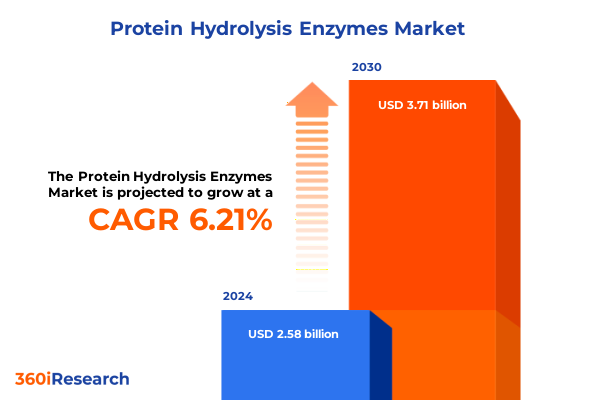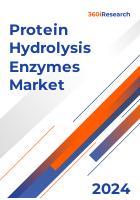The Protein Hydrolysis Enzymes Market size was estimated at USD 2.58 billion in 2024 and expected to reach USD 2.75 billion in 2025, at a CAGR 6.21% to reach USD 3.71 billion by 2030.

Introduction to the Role and Relevance of Protein Hydrolysis Enzymes
Protein hydrolysis enzymes serve as indispensable biocatalysts that cleave peptide bonds, converting complex proteins into peptides and amino acids. Their applications span food processing, where they enhance flavor and digestibility; pharmaceuticals, through targeted peptide production; animal feed, by improving nutrient availability; and cosmetics, via bioactive peptide generation. Given mounting consumer interest in functional foods and personalized nutrition, these enzymes are pivotal in crafting high-value ingredients such as hypoallergenic protein hydrolysates, bioactive peptides with health-promoting properties, and specialty protein fractions.
In recent years, innovations in enzyme engineering and bioprocess optimization have driven efficiency gains and expanded the substrate repertoire. Furthermore, advances in downstream processing and enzyme immobilization have elevated stability and reusability, aligning with sustainability objectives. As a result, stakeholders across the value chain-from raw material suppliers to end-product manufacturers-are capitalizing on technological breakthroughs to differentiate offerings and address evolving regulatory requirements. Consequently, understanding the enzyme portfolio, market dynamics, and emerging trends is essential for informed decision-making and competitive positioning in this rapidly evolving sector.
Transformative Shifts Reshaping the Protein Hydrolysis Enzymes Market
The landscape of protein hydrolysis enzymes is undergoing transformative shifts driven by technological innovation, sustainability imperatives, and changing consumer preferences. Advances in computational protein engineering now enable precise modification of catalytic sites, enhancing specificity and activity under diverse processing conditions. Moreover, the integration of artificial intelligence in enzyme discovery accelerates lead identification, reducing time-to-market for novel biocatalysts. These capabilities empower manufacturers to tailor enzymes for plant-based protein sources, addressing growing demand for alternatives to animal-derived proteins.
Simultaneously, green biomanufacturing is gaining traction: bioprocesses leveraging microbial fermentation of engineered strains minimize energy consumption and waste generation. In addition, continuous flow reactors are replacing traditional batch processes, delivering consistent quality and scalable production. Personalization trends in nutrition are also shaping enzyme applications, with custom hydrolysates formulated to meet individual dietary needs and health goals. As a result, companies that embrace these shifts by investing in R&D, forging cross-sector partnerships, and adopting digital platforms will secure competitive advantages and drive sustainable growth.
Cumulative Impact of U.S. Tariffs Enacted in 2025
The introduction of new U.S. tariffs in 2025 has exerted a cumulative impact on the protein hydrolysis enzymes sector, prompting supply chain realignments and cost structure adjustments. Imports of key enzyme preparations and raw materials from major suppliers faced duty increases, translating into higher landed costs for manufacturers. Consequently, some end users reassessed sourcing strategies, shifting towards domestic enzyme producers or near-shore suppliers to mitigate tariff-related expenses.
Moreover, tariff-driven price pressures have stimulated investment in localized production capabilities, particularly within North America, to ensure supply continuity and control quality. Regulatory compliance costs also rose, as companies navigated varying classification rules and documentation requirements. In response, industry leaders have intensified collaboration with government agencies and trade bodies to advocate for harmonized standards and favorable trade agreements. Overall, the 2025 tariff adjustments underscore the importance of diversified sourcing, robust risk management, and strategic partnerships in maintaining competitive resilience.
Key Segmentation Insights Across Source Types and Enzyme Classes
Segmentation analysis reveals that protein hydrolysis enzymes can be categorized by source type and enzyme class, each offering unique opportunities. Based on source type, animal-derived enzymes-encompassing albumin, collagen, and dairy proteins-continue to dominate legacy applications due to well-established supply chains and robust regulatory approvals. At the same time, microbial sources, including both bacterial proteins and fungal proteins, are gaining market share through scalable fermentation platforms and tailored specificity. In parallel, plant-derived sources such as oat, pea, rice, and soy proteins are emerging as future growth drivers, supported by consumer interest in vegan and clean-label solutions.
From an enzyme-type perspective, the market is divided into carbohydrases, lipases, and proteases. Within carbohydrases, amylases and xylanases facilitate starch and hemicellulose breakdown, respectively, enhancing functional properties in food and feed. Lipases are employed for lipid modification and flavor enhancement, while proteases-both endoproteases and exoproteases-are central to protein hydrolysis across multiple industries. Understanding these segmentation dimensions enables stakeholders to align product development and marketing strategies with specific end-use requirements and growth pockets.
This comprehensive research report categorizes the Protein Hydrolysis Enzymes market into clearly defined segments, providing a detailed analysis of emerging trends and precise revenue forecasts to support strategic decision-making.
- Source Type
- Enzyme Type
Key Regional Insights: Americas, EMEA, and Asia-Pacific Trends
Regional dynamics in the protein hydrolysis enzymes market exhibit distinct patterns driven by local demand, regulatory landscapes, and manufacturing capabilities. In the Americas, robust growth in functional foods and nutraceuticals, particularly in the United States, has fueled enzyme adoption, while Canada and Latin American markets are expanding through investments in feed and bioethanol industries. Transitioning to Europe, Middle East & Africa, stringent food safety regulations and sustainability mandates have incentivized the development of eco-friendly biocatalysts and, in parallel, spurred innovation hubs in Western Europe, while emerging markets in the Middle East and Africa focus on capacity building.
Moving eastward, the Asia-Pacific region stands out for rapid industrialization, rising disposable incomes, and a burgeoning health-conscious middle class. Leading markets such as China, Japan, India, and Southeast Asian nations are scaling up both consumption and local manufacturing of protein hydrolysis enzymes. Incentive programs and technology transfer initiatives are further accelerating domestic production, making the region a critical growth engine for enzyme suppliers and end users alike.
This comprehensive research report examines key regions that drive the evolution of the Protein Hydrolysis Enzymes market, offering deep insights into regional trends, growth factors, and industry developments that are influencing market performance.
- Americas
- Asia-Pacific
- Europe, Middle East & Africa
Leading Companies Driving Innovation and Competitive Differentiation
Competitive analysis highlights a diverse landscape of established multinationals and specialized enzyme developers driving innovation across the value chain. Global leaders such as Novozymes Group, Koninklijke DSM N.V., BASF SE, Merck KGaA, F. Hoffmann-La Roche Ltd., and Solvay S.A. leverage extensive R&D resources and integrated biomanufacturing platforms. In parallel, companies including AB Enzymes GmbH, Advanced Enzyme Technologies Limited, and Amano Enzyme Inc. focus on tailored enzyme solutions for food and specialty applications. AngelYeast Co., Ltd. and Jiangsu Yiming Biological Technology Co., Ltd. are expanding their microbial fermentation capabilities to serve both domestic and export markets.
Meanwhile, Codexis, Inc. and Biocatalysts Ltd. exploit protein engineering and high-throughput screening to develop next-generation catalysts, whereas Creative Enzymes and Enzyme Development Corporation offer custom enzyme discovery and production services. Kemin Industries, Inc. and Kerry Group PLC integrate enzyme innovations into comprehensive ingredient portfolios, while Megazyme Ltd. and SILAB emphasize analytical reagents and cosmetic bioactives. Specialty Enzymes & Probiotics, SYMBIO, TAKABIO, and Xiasheng (Beijing) Biotechnology Development Co., Ltd. further enrich the competitive mix with niche applications in animal health, probiotics, and industrial processes.
This comprehensive research report delivers an in-depth overview of the principal market players in the Protein Hydrolysis Enzymes market, evaluating their market share, strategic initiatives, and competitive positioning to illuminate the factors shaping the competitive landscape.
- AB Enzymes GmbH
- Advanced Enzyme Technologies Limited
- Amano Enzyme Inc.
- AngelYeast Co., Ltd.
- BASF SE
- Biocatalysts Ltd.
- Codexis, Inc.
- Creative Enzymes
- Enzyme Development Corporation
- F. Hoffmann-La Roche Ltd.
- Jiangsu Yiming Biological Technology Co., Ltd.
- Kemin Industries, Inc.
- Kerry Group PLC
- Koninklijke DSM N.V.
- Megazyme Ltd.
- Merck KGaA
- Novozymes Group
- SILAB
- Solvay S.A.
- Specialty Enzymes & Probiotics
- SYMBIO
- TAKABIO
- Xiasheng (Beijing) Biotechnology Development Co., Ltd.
Actionable Recommendations for Industry Decision-Makers
Industry leaders should prioritize several actionable strategies to capitalize on market opportunities and mitigate risks. First, investing in advanced enzyme engineering platforms-incorporating artificial intelligence and machine learning-will accelerate discovery and customization for emerging protein sources. Second, diversifying supply chains by establishing regional manufacturing hubs and forging strategic partnerships can reduce exposure to tariff fluctuations and logistics disruptions. Third, adopting green bioprocesses and circular economy principles, such as enzyme recycling and waste valorization, will meet tightening sustainability regulations and consumer expectations.
In addition, companies should engage proactively with regulatory bodies to streamline approval pathways and harmonize classification standards across key markets. Building cross-sector ecosystems-linking raw material suppliers, contract manufacturers, and end users-can foster collaborative innovation and shared R&D costs. Finally, enhancing digital capabilities in quality control, process monitoring, and predictive maintenance will improve operational efficiency and ensure consistent enzyme performance.
Explore AI-driven insights for the Protein Hydrolysis Enzymes market with ResearchAI on our online platform, providing deeper, data-backed market analysis.
Ask ResearchAI anything
World's First Innovative Al for Market Research
Conclusion: Navigating Opportunities in a Dynamic Enzyme Market
In summary, the protein hydrolysis enzymes sector is characterized by rapid technological advancements, evolving regulatory frameworks, and shifting consumer preferences. Segmentation across source types and enzyme classes illuminates clear pathways for targeted product development, while regional insights underscore the importance of localized strategies. The competitive landscape, marked by both global majors and agile specialists, highlights the value of innovation, collaboration, and operational excellence. By embracing enzyme engineering, sustainable bioprocessing, and digital transformation, stakeholders can address emerging protein demands, navigate trade complexities, and secure long-term growth in this dynamic market.
This section provides a structured overview of the report, outlining key chapters and topics covered for easy reference in our Protein Hydrolysis Enzymes market comprehensive research report.
- Preface
- Research Methodology
- Executive Summary
- Market Overview
- Market Dynamics
- Market Insights
- Cumulative Impact of United States Tariffs 2025
- Protein Hydrolysis Enzymes Market, by Source Type
- Protein Hydrolysis Enzymes Market, by Enzyme Type
- Americas Protein Hydrolysis Enzymes Market
- Asia-Pacific Protein Hydrolysis Enzymes Market
- Europe, Middle East & Africa Protein Hydrolysis Enzymes Market
- Competitive Landscape
- ResearchAI
- ResearchStatistics
- ResearchContacts
- ResearchArticles
- Appendix
- List of Figures [Total: 20]
- List of Tables [Total: 324 ]
Next Steps: Engage with Ketan Rohom to Acquire the Full Report
To access the comprehensive market research report and discuss tailored solutions, please contact Ketan Rohom, Associate Director, Sales & Marketing. Ketan can guide you through the report’s insights and help you leverage data-driven strategies for competitive advantage.

- How big is the Protein Hydrolysis Enzymes Market?
- What is the Protein Hydrolysis Enzymes Market growth?
- When do I get the report?
- In what format does this report get delivered to me?
- How long has 360iResearch been around?
- What if I have a question about your reports?
- Can I share this report with my team?
- Can I use your research in my presentation?




